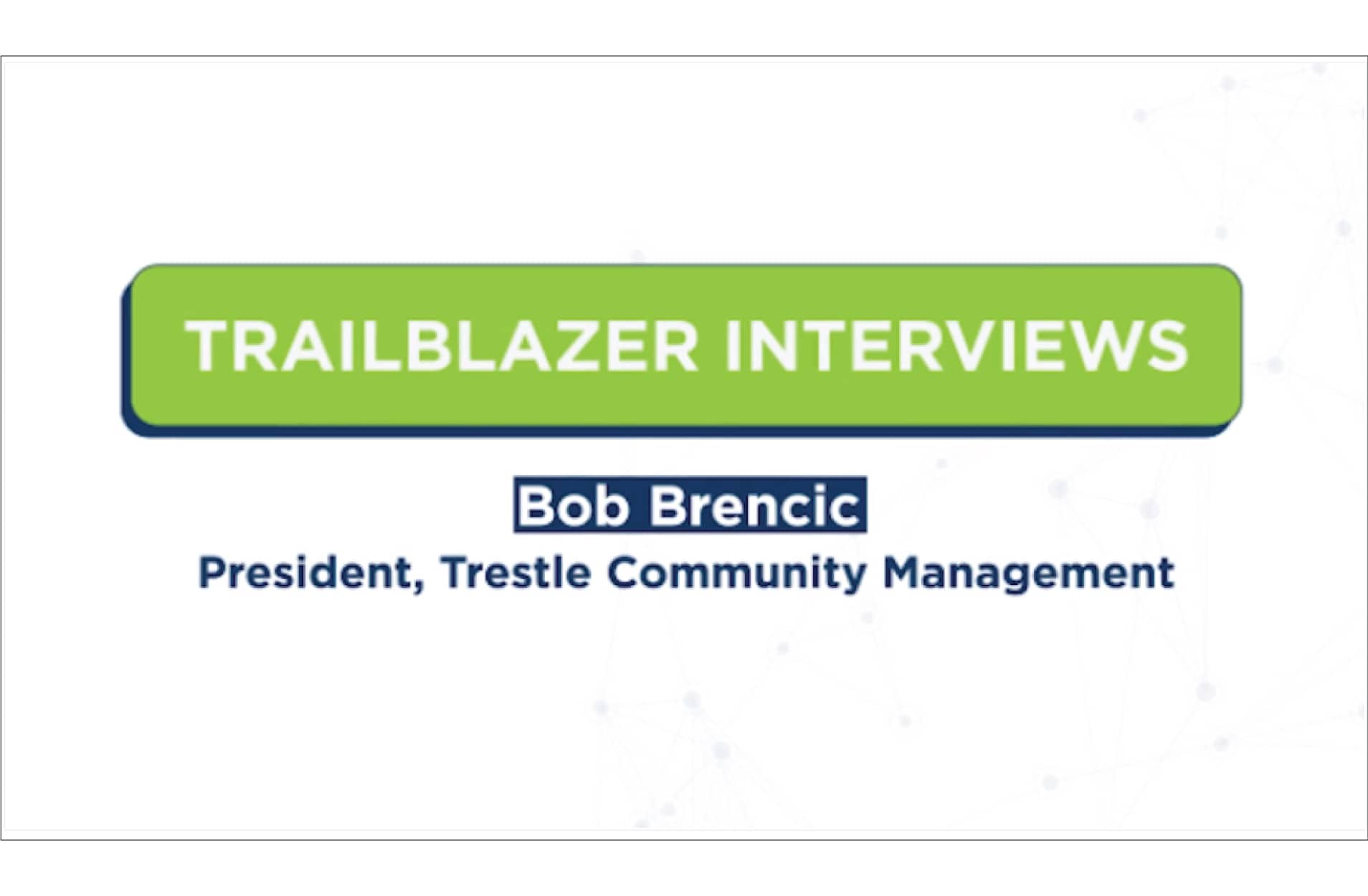Association Management Trailblazers: Bob Brencic

Trestle Community Management is on a tear, twice earning Inc 5000 recognition for rapid growth. In this episode, CEO Bob Brencic outlines shares keys to his organization’s success, from maintaining a technology edge to choosing clients wisely based on your business strengths. Watch it now!
Prefer to read?
Here’s the transcript!
[Jonathan] Welcome to everyone joining us live or watching the replay. My name is Jonathan Corke at FRONTSTEPS, and I am thrilled to be alongside Bob Brencic of Trestle Community Management to unpack what’s happening in HOA, to pick his brain, and have some fun as we do it. Bob, thank you so much for joining us.
[Bob] My pleasure. Thanks for having me, Jonathan.
[Jonathan] Yeah. And as we talked about sort of off-stage, right, this is a new idea for us, and it really crystallized after having some conversations in other venues with you, in particular, Bob, and some other HOA executives. It just seems like there’s so much in your brain and there’s so much happening in the world that there’d be plenty of people who would like to learn a little bit more about how you’re responding, how you’re helping your team and your clients respond to this dynamic environment. But before we jump into sort of the here and now as it relates to HOA, I always like to start with you, right, and help the audience understand a little more about you because very few people, I think, sort of naturally fall into or choose HOA management as a career. So we’d love for you to give the audience a little bit of a flavor of how you arrived in this space and what intrigued you or interested you about it?
[Bob] It’s a great question. It’s interesting. Everybody in the industry is always interested in how people got into it because it’s not an industry that you can go to college to learn, right? But I entered the community management business nearly 8 years ago after a 25-year career in the high tech industry. I personally reached a milestone in my life where I wanted to work for myself. So I took a year off and analyzed various industries, and that led me to the community association management industry because, at the time, I felt like it really complimented my skill set and experience set that I had in high tech. Many of the aspects that I commonly performed are similar to what community managers do. Project management, working with boards of directors, the financial, and reporting were all similar to businesses I led in high tech. But frankly, what led me to the industry was what I felt was a lack of professionalism and a lack of technology awareness at many of the companies I’d be competing against. And that was a result of the research I was performing before entering into the industry. I felt that if I ran this business as a real business, like a law firm or a CPA firm, that we’d be very successful. And so I went out and purchased a couple of community management firms 8 and 7 years ago, integrated them into one, and here we are today.
[Jonathan] So now tell me about your organization. Tell me about Trestle Community Management in a few words.
[Bob] To give you a little background on Trestle. Trestle Community Management we have been the most recognized community management firm in Washington State the last several years. We were twice named one of Washington’s 100 best workplaces. Last year, we were awarded Business Partner Company of the Year by our local state chapter of the Community Association Institute. And I think these are just proof points for how we operate the company. We focus on running the best and most progressive organization in our market, and that’s led to amazing growth for us. We’ve been growing at 50% per year for several years, and that resulted in our twice being named one of Washington’s fastest-growing private companies lists and also on the Inc. 5000 lists two times. So we grew Trestle just from 2 of us, 12 clients, and 500 homes working out of my house to 160 clients, 40 people, and over 11,000 homes last year. The growth’s been excellent, but we’ve been more focused, as you surmised, Jonathan, on delivering the best service and the best innovation to lead the industry in our market, and growth’s just been a result of doing those things really, really well.
[Jonathan] Earlier, you mentioned bringing a technical acumen to this industry and making sound technology decisions. Could you elaborate a bit on that? What does that mean, and how do you go about introducing and then using and getting the value from the right solutions?
[Bob] From our perspective, anything that revolves around delivering the best quality of service and results to our clients are what we’re focused on. And from the onset, we said we’d be the most professional and execution-oriented firm in our market, and that’s never changed. It’s easy to say, but what does it mean to do that? You have to have excellent processes, to begin with, right? And then, you have to apply the best technology that’s out there to automate those processes. And if you could do both those at the same time or customize your processes to meet the great technology and be very efficient, is even better. But it’s also partnering with the best firms out there. Who are the best partners for our firm that’s going to help keep us on an industry-leading trend as we go forward, company like FRONTSTEPS, for example? And then, also, complementing all that with the ability to hire and retain the best people that we can. Each of these have a myriad of challenges and projects behind them that we have deployed and improved many times over and over again in the last seven years. You just can’t deploy technology and processes and hire a few people and say, “Okay, we’re all done.” The industry is always evolving. The technologies are always evolving. So what you have to say is you have to have a continual, never-ending questioning about what you could do better and better, and eventually, you end up a leader in all those categories that I mentioned that no other competitor can keep up with.
[Jonathan] So when you think about how community association management is changing, especially of late, and maybe how it looks like it might continue to change, what’s top of mind for you?
[Bob] That’s a great question. I’ve been in the industry eight years, which I’m still an infant relative to a lot of people in this industry, right? But the amount of change that we’ve seen, especially in the last three years, is incredible, just incredible. I felt like we were so far out in front of everybody. Three years ago, we were working on– we were deploying work at home and remote work back then. So when COVID hit, we simply closed the office, and everybody started working at home, and we didn’t skip a beat. We had everything already in place. But COVID really forced a lot of change in a very short amount of time for a lot of people in our industry. I think it woke up a lot of sleepy companies in our market and forced them to deploy new methods and technologies that allowed them to work remotely, meet remotely, and reexamine how they need to move forward in this new world.
[Jonathan] You may know we conducted a survey through CAI earlier this year, and some of the questions we posed to CAMs, community association managers, were around their most burning issues, their biggest challenges today. And the one that rose to the very top of the list was heightened homeowner expectations. You use that word expectations, too. It seems like the bar has risen or is rising. So, what’s your reaction to that being on top of the list, and does that play into your thinking?
[Bob] Well, yeah. It’s a key trend, and it’s accelerating over the last few years in terms of the volume of communications coming in, whether emails, voice mails, phone calls, it’s accelerating. And the expectation from the homeowners and the board members are to respond even faster and faster. It’s almost become text-like in terms of the expectation of responses. And I think long gone are those days where you could expect a community manager to attend a monthly board meeting, answer a few phone calls, and that’s it. Today, the flow of information is so fast, right? And it has to be constant and nearly instantaneous in terms of how we respond to those. So how do you remove a community manager from being the neck in the funnel so no single person can respond to the wave of requests coming at them?
Now, we’ve always had a web portal, and so owners could do self-service as much as possible. That’s helped a lot. And frankly, having a well-run informational portal is, in my mind, table stakes. If a firm doesn’t have a portal today, it’s like not being able to receive bank ACHs and electronic payments from owners five years ago. So, you have to be there with the portal. We deployed a client experience team that will help the community manager out in answering 80% of the easy questions that come in via phone call or email, right? What’s my account balance? How do I order resale certificate? How do I change my contact information? Those are all on the portal. But some people still want that level of personal touch. So, everything can’t go completely virtual, at least not yet, but maybe someday we’ll get there.
[Jonathan] How has your thinking about, again, technology, information, and sort of that highway of your data or your workflows, how has that needed to change, if at all, to sort of keep pace with your business growth?
[Bob] So having a system that’s fully integrated is absolutely key to our success. Now, you get into the staffing and the ability to recruit people. Staffing today it’s actually quite concerning, and I think this issue’s going to be with us a very long time. It’s not going to go away anytime soon. We’re seeing less experienced and less professional community managers in the industry today. And if that’s not addressed, it’s going to limit companies’ ability to grow. So what can you do? What are we doing? Well, first, we’re being very selective in the clients that we’re accepting into our firm. We’re looking only for the best clients to deal with. Not only the best clients, but the best clients to deal with that are a pleasure to work with that are exciting to work with for our people, right? And having that kind of reputation in our area, people want to come work for a firm that only works with the best clients, right, and that are treated with respect and viewed as a professional. So that’s one of the key things that we’re really focused on, is continuing professionalism in our firm.
[Jonathan] Yeah, and it’s impressive, and it’s testament to why we reached out to you, Bob, right, Is to provide that perspective. Sometimes, you’re looking for a silver bullet, right? Sometimes, you’re looking for a simple answer, but it’s often, in this environment, all of those efforts are worth the time and having the right people and the right clients. It’s a magical combination.


